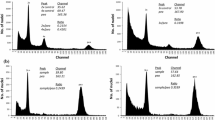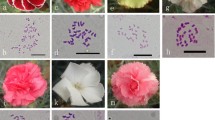Summary
Pollinating radish (n = 9) by turnip (n = 10) gave, amongst other plants, a triploid hybrid with 2n = 28; probably from a diploid radish egg-cell.
By open pollination the triploid hybrid gave a varied progeny including two hexaploid plants with 2n = 56. These resembled the triploid in appearance, and were almost sterile.
In open pollination the functional egg-cells were chiefly triploid, but some had 9 chromosomes, and were genetically similar to those of radish.
The pollen of the triploid, like the egg-cells, showed a wide range from 9 chromosomes probably up to triploid. Used on radish, however, it was chiefly that with 9 chromosomes, similar to those of radish, that gave progeny, though some 10 chromosome pollen also was functional. Thus, apparently, triploid pollen was functional on the triploid but not on radish, probably owing to the chromosome ratio between pollen and stigma.
From the back-cross to radish a plant with a single extra turnip chromosome appeared to be identical with radish except for its reduced fertility.
Similar content being viewed by others
References
Catcheside, D. G. (1934). “The chromosomal relationships in the swede and turnip groups ofBrassica.”Ann. Bot. 48, 601–33.
Fukushima, E. (1930). “Formation of diploid and tetraploid gametes inBrassica.”Jap. J. Bot. 5, 273–82.
Karpechenko, G. D. (1928). “Polyploid hybrids ofRaphanus sativus × Brassica oleracea.”Z. indukt. Abstamm.- u. VererbLehre,48, 1–85.
Maeda, T. &Sasaki, T. (1934). “Chromosome behaviour in the pollen mother cells ofRaphanus sativus.”Jap. J. Genet. 10, No. 1, 78–83.
Moldenhauer, C. (1925). “Etudes sur le croisement deRaphanus avecBrassica.”Bull. int. Acad. Cracovie, B, 537–60.
Morinaga, T. (1929). “Interspecific hybridization inBrassica, 3.”J. Dep. Agric. Kyushu Univ. 2, No. 7, 199–206.
Terasawa, Y. (1933). “On the form of fruits of the hybrid plant betweenBrassica andRaphanus.”Proc. Crop Sci. Soc. Japan,5, 107–15. English abstract inPlant Breed. Abst. (1933),4, No. 179, p. 59.
U, N. (1935). “Genome analysis inBrassica, etc.”Jap. J. Bot. 7, 389–452.
Uphof, J. C. Th. (1924). “On Mendelian factors in radishes.”Genetics,9, 292–304.
Watkins, A. E. (1932). “Hybrid sterility and incompatibility.”J. Genet. 25, 125–62.
Author information
Authors and Affiliations
Rights and permissions
About this article
Cite this article
Morris, L.E., Richharia, R.H. A triploid radish × turnip hybrid and some of its progeny. Journ. of Genetics 34, 275–286 (1937). https://doi.org/10.1007/BF02982268
Issue Date:
DOI: https://doi.org/10.1007/BF02982268




